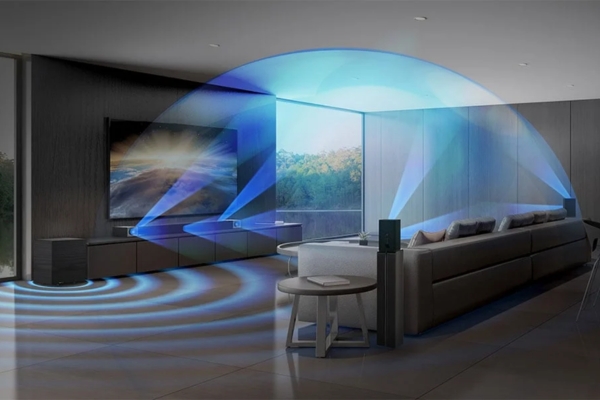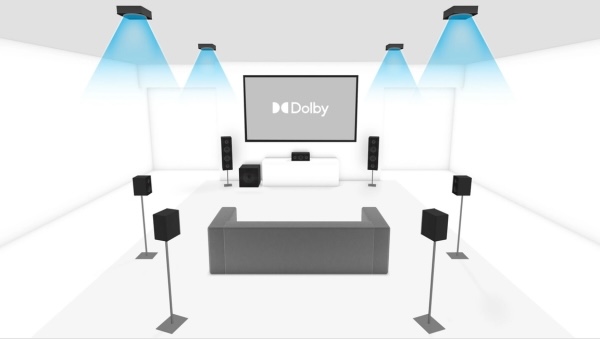How to Build the Perfect Dolby Atmos Home Theatre Experience
With modern home theatre technology, experiencing the very best soundscapes of blockbuster at home has never been more accessible. Dolby Atmos, an advanced object-based audio format, has revolutionized home entertainment by creating a three-dimensional sound environment.
Unlike traditional surround sound, which distributes sound across fixed channels at ear level, Atmos introduces height channels, enveloping the audience in sound from all directions, including overhead. This innovation makes effects like rainfall, helicopters, and even subtle atmospheric details feel remarkably lifelike.
There are several ways to bring Dolby Atmos into your home. Some high-end soundbars attempt to replicate multi-speaker configurations using upward-firing drivers that bounce sound off the ceiling, creating a virtual Atmos effect.
But, for the most authentic and impactful experience, a dedicated AV receiver paired with a properly configured speaker setup is the best route. This will ensure that sounds are reproduced with precision, making your home theatre truly come alive.
What is Dolby Atmos? A New Dimension of Sound
At its core, Dolby Atmos is a groundbreaking advancement in surround sound technology that moves beyond the limitations of traditional channel-based audio.
In conventional 5.1 or 7.1 surround sound systems, audio is confined to specific speakers at ear level, limiting the depth and realism of the sound field. Atmos expands this by introducing height channels, allowing sound to move in three dimensions—side to side, front to back, and above the listener—creating a more immersive and lifelike experience.
This is made possible through object-based audio processing, a technique that assigns individual sounds, or “objects,” to precise locations within a three-dimensional space. Instead of a fixed number of audio channels, an Atmos mix adapts dynamically to your specific speaker configuration.
You can have a basic 5.1.2 setup (five ear-level speakers, one subwoofer, and two height speakers) or a full-scale 7.1.4 system (seven ear-level speakers, one subwoofer, and four height speakers). A modern AV receiver automatically detects your speaker configuration and optimizes the audio mix to ensure its tailored to your setup.
Whether you have in-ceiling speakers, wall-mounted height channels, or upward-firing modules, Dolby Atmos brings an entirely new dimension to home audio, making your favourite movies, TV shows, and music sound better than its ever sounded before.

What Speakers Do You Need for a Dolby Atmos Home Theatre?
If you have the space and budget for a true Dolby Atmos setup, investing in a multi-speaker system will provide the most immersive experience. Many home theatre enthusiasts already have existing 5.1 or 7.1 surround setups, which can be upgraded by simply adding height speakers for Atmos effects.
A traditional surround sound system consists of:
- Front left and right speakers – The primary drivers of music and effects, often full-range speakers.
- Center channel speaker – Handles dialogue and critical midrange sounds.
- Surround speakers (side and/or rear) – Create directional sound cues and ambient effects.
- Subwoofer (.1 channel) – Provides low-frequency effects (LFE), enhancing bass impact.
For a Dolby Atmos setup, additional height speakers are introduced, creating configurations such as:
- 5.1.2 – Five traditional surround speakers, one subwoofer, and two height speakers.
- 7.1.4 – Seven surround speakers, one subwoofer, and four height speakers.
The type of Atmos speakers you choose can significantly affect your experience:
- Ceiling-mounted speakers – The most effective solution, placing sound directly above the listener.
- Upward-firing Atmos-enabled speakers – These sit atop existing speakers and bounce sound off the ceiling to simulate height effects.
- Wall-mounted or angled height speakers – Placed high on walls and directed towards the listening area to create a similar effect.
For front left and right, full-range floorstanding speakers are ideal, but bookshelf speakers with a subwoofer can also work well. Height speakers don’t need to be as powerful as the main speakers, as they primarily enhance ambient effects rather than directional sounds.
When setting up your system, prioritize high-quality front and center speakers, as these handle most of the soundtrack. Surround and height channels can be added gradually over time to expand your system and enhance the immersive Atmos effect.

Setting Up Your Dolby Atmos Home Theatre System
Setting up a Dolby Atmos system requires careful speaker placement and calibration to fully optimize the immersive effect. Most modern AV receivers come with a user-friendly setup interface, helping you configure your system step by step.
Ideally, if you are designing a home theatre from scratch, you have the freedom to position speakers optimally and conceal wiring within walls for a clean, professional look. Even if retrofitting into an existing space, thoughtful speaker placement will yield impressive results.
Beyond speaker positioning, room acoustics play a crucial role in maximizing Atmos performance. Hard surfaces like bare walls and floors can create unwanted sound reflections, reducing clarity and immersion.
To counteract this, consider adding acoustic treatments such as wall panels, thick rugs, or curtains to absorb excess reverb and enhance sound precision.
Fine-Tuning Your System for the Best Sound
Once the speakers are placed, your AV receiver’s room calibration software—such as Audyssey, Dirac Live, or Yamaha’s YPAO—can further refine the sound. These systems use a microphone to analyze your room’s acoustics and adjust speaker levels, delay, and frequency response accordingly.
Wiring and Connectivity Considerations
If running speaker cables through walls isn’t an option, high-quality wireless Atmos speaker options are available for some systems. However, for the best reliability and audio fidelity, wired connections are still the preferred choice.
Additionally, ensure that your HDMI cables support eARC (Enhanced Audio Return Channel) to transmit uncompressed Atmos signals from compatible TVs and streaming devices.

Testing Your Dolby Atmos System
After setup, test your system with Atmos demo clips or compatible movie scenes to ensure proper speaker output and spatial accuracy. Many streaming services and 4K Blu-rays offer reference-quality mixes that allow you to fine-tune your system further.
Adjusting small details like speaker crossover settings, subwoofer placement, or dialogue enhancement modes can make a noticeable difference in overall performance.
Is Dolby Atmos Right for You?
Investing in a Dolby Atmos home theatre is a sizeable cost, but for those who demand the most immersive sound experience possible, it’s an investment that pays off in every way.
Configuring a multi-speaker Atmos system with a dedicated AV receiver takes time, effort, and planning, but the results are nothing short of spectacular. Even compared with surround sound, the difference is immediately noticeable. Sound no longer just moves around you but also above you, creating a sense of depth and realism that standard setups can’t replicate.
For home theatre enthusiasts , a multi-channel receiver with height speakers is the gold standard. However, for those with space or budget constraints, Atmos-enabled soundbars and virtualized Atmos solutions still offer a substantial improvement over conventional audio setups.
The beauty of Atmos is that it scales with your setup, allowing you to start small and expand over time. Enjoy!
Check out more from our Soundrating Blog…
Understanding Audio Receivers: The Heart of Your Sound System

I am a passionate and skilled car audio enthusiast with 15 years of experience in the industry. My journey started when I replaced my first set of factory car speakers, sparking a deep love for high-quality sound. Since then, I have worked as a representative for renowned brands like Kenwood and Alpine.
With a background in both retail and distribution, I have developed a comprehensive understanding of the car audio market. Currently a certified (MECP) installer in the Mobile Electronics industry, my expertise lies in delivering top-notch audio installations. My knowledge, coupled with my genuine passion, makes me the go-to professional for all car audio needs.
